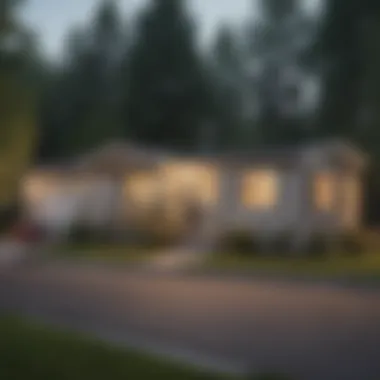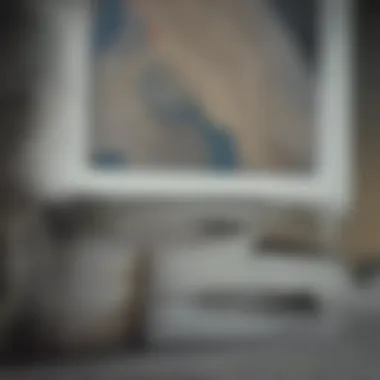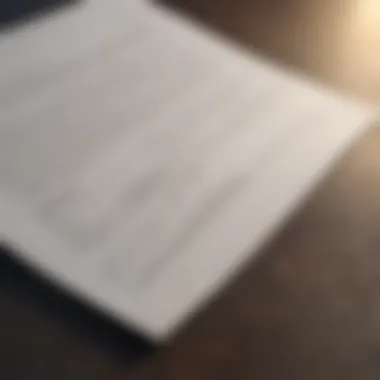Understanding Manufactured Home Insurance Costs


Intro
Insuring a manufactured home involves unique complexities, differing from traditional home insurance. Many variables combine to form the insurance premium structure. Homeowners must navigate different elements to see how they affect coverage costs. Understanding these components prepares individuals to make educated decisions.
Coverage Options
Types of Coverage Available
When insuring a manufactured home, it is crucial to consider what types of coverage are available. Not all insurance policies are created equal, combining various options that can significantly influence the cost. Some common types of coverage include:
- Dwelling Coverage: Protects the structure of the home itself against specific hazards.
- Personal Property Coverage: Covers personal belongings within the home, like furniture and electronics.
- Additional Living Expenses: Provides funds for temporary housing if the home becomes uninhabitable due to a covered loss.
- Other Structures Coverage: Offers protection for external structures such as sheds or fences.
The selection and combination of these types will depend on personal preferences and risk considerations.
Liability Coverage Explained
Liability coverage is another essential element of manufactured home insurance. It protects homeowners in case someone is injured on their property. This coverage can help pay for medical bills, legal fees, or damages awarded in a lawsuit. A strong liability coverage can be a safety net, but it often raises the overall insurance cost. Homeowners should evaluate their risk profile to determine how much liability coverage is necessary for their circumstances.
Key Considerations
Factors to Assess When Choosing Insurance
Several factors can affect the cost of insuring a manufactured home. Location remains one of the most significant influences on insurance rates. Homes in areas prone to natural disasters, such as floods or earthquakes, typically face higher premiums. Additionally, the home's age and condition can impact coverage costs. Older manufactured homes may have a higher likelihood of issues, leading to increased insurance needs.
Homeowners should also consider their credit history. Insurers often look at credit scores when determining premiums. This practice, though controversial, usually reflects how responsible a homeowner is in managing finances. To lower costs, maintaining a good credit score is advisable.
Understanding Policy Limits
A vital aspect of selecting the right insurance policy is understanding policy limits. Policy limits define the maximum amount an insurer will pay for a covered loss, and they can vary significantly based on the type of coverage chosen. Homeowners need to evaluate their specific needs when deciding on coverage limits. Under-insuring a manufactured home can lead to financial distress in case of a serious incident. Conversely, over-insuring may result in paying for unnecessary coverage.
"Understanding the specifics of your policy is essential in ensuring your manufactured home is adequately protected."
By recognizing the critical factors that determine insurance costs, homeowners can make decisions that align with their financial goals and risk tolerance. Through careful assessment of coverage options and key considerations, individuals will be better equipped to navigate the complexities of insuring their manufactured homes.
Intro to Manufactured Home Insurance
Understanding manufactured home insurance is essential for homeowners who own or are considering owning a manufactured home. This type of insurance provides protection tailored to the unique needs of manufactured home owners, ensuring that they are covered against various risks. As manufactured homes differ from traditional homes, their insurance policies also require a distinct approach.
Many people might not realize that manufactured homes, often referred to as mobile homes, have specific characteristics that impact the type of coverage needed. Factors like materials, value, and location play a crucial role in determining insurance costs. Understanding these elements helps in making an informed decision when choosing an insurance policy.
Additionally, homeowners should be aware of the importance of adequate coverage. Many people underestimate the potential risks associated with manufactured homes, including natural disasters, theft, and liability claims. By not having proper insurance, they may face financial hardships in the event of an unforeseen incident. Therefore, this article aims to equip homeowners with essential knowledge about manufactured home insurance, guiding them to select the best coverage based on their circumstances.
Definition of Manufactured Homes
Manufactured homes are factory-built houses that are transported to their location. Unlike traditional homes, they are constructed on a permanent chassis and typically arrive at the site already assembled or in sections. This method of construction can lead to significant cost savings compared to traditional stick-built homes. Typically, manufactured homes are cost-effective solutions for housing, making them an attractive option for many.
Difference Between Manufactured and Traditional Homes
The primary distinction between manufactured and traditional homes lies in their construction and placement. Traditional homes are built on-site using wood framing, while manufactured homes are built entirely in a factory. Once shipped, manufactured homes must comply with specific federal regulations set by the U.S. Department of Housing and Urban Development (HUD).
Some key differences include:
- Foundation: Traditional homes usually rest on a permanent foundation, while manufactured homes can sit on a simple platform or be transported.
- Construction Standards: Manufactured homes must adhere to HUD standards, which are not applicable to conventional homes.
- Financing Options: Financing a manufactured home may differ from traditional homes, affecting insurance costs and availability.
Understanding these differences is vital for homeowners when navigating insurance options. Each type of home has its own set of risks, which directly influences insurance policies and premiums.


The Importance of Insurance for Manufactured Homes
Insurance for manufactured homes is not just a regulatory requirement; it is a fundamental need that protects homeowners' investments. This section explains the specific benefits that arise from obtaining insurance, particularly in the context of manufactured homes.
Protecting Your Investment
Homeownership represents a significant financial commitment. A manufactured home may cost less than a traditional one, but it still warrants protection. Without insurance, homeowners risk losing their property to unforeseen disasters, such as fires, floods, or severe weather. Insurance serves as a safety net. It helps cover repair or replacement costs, reducing the financial burden on homeowners in the event of damage.
Moreover, financial institutions often require insurance when financing a manufactured home. This ensures that their loan is protected, and that the home remains valuable. The right policy can prevent homeowners from facing financial ruin while they navigate through life’s uncertainties.
Mitigating Risks and Liabilities
Every homeowner must confront various risks. For manufactured homes, these risks might include damage from extreme weather, mold, or vandalism. By having adequate insurance, homeowners can significantly mitigate these risks.
In addition to property damage, homeowners may face liability issues. If someone is injured on their property, they could face legal implications. Liability insurance included in a homeowners’ policy can cover medical expenses or legal fees, providing peace of mind.
In summary, the significance of obtaining insurance for manufactured homes cannot be overstated. It assures the safeguarding of valuable investments and offers protection against potential liabilities.
Key Factors Affecting Insurance Costs
Understanding the key factors that influence insurance costs for manufactured homes is essential for homeowners. These elements not only determine the premiums but also impact the coverage options available to the homeowner. Many people tend to overlook these factors, assuming that insurance costs are standardized across policies. However, this is not the case. Each individual situation plays a significant role in calculating insurance rates.
Location and Its Impact on Premiums
The location of a manufactured home heavily affects insurance premiums. Homes situated in areas prone to natural disasters, such as floods or hurricanes, face higher insurance costs. This is due to the increased risk of damage, which insurers factor into the pricing model. Moreover, urban areas with higher crime rates can also lead to elevated premiums. Homeowners in safer neighborhoods often receive lower rates.
In addition, proximity to essential services, such as fire departments or emergency medical teams, may also influence the cost. Homes closer to these services tend to enjoy lower premiums as they mitigate risk. Adjusting the coverage limits and deductibles based on the location can significantly impact overall insurance costs.
Age and Condition of the Manufactured Home
Another crucial factor is the age and general condition of the manufactured home. Older homes may not meet current safety codes or standards, increasing their risk profile. Insurers often categorize older homes as higher risk, leading to increased premiums. Conversely, homes that are well-maintained or have undergone recent renovations usually attract lower insurance costs since their risk is reduced.
Homeowners should consider regular maintenance and updates. This not only improves the home's value but also lowers insurance rates. A thorough home inspection can also reveal any issues that could affect the insurance coverage. Regular upkeep ensures that the home stays in good condition, potentially avoiding coverage disputes during claims.
Safety Features and Upgrades
Safety features and upgrades play an important role in determining insurance premiums. Homes equipped with advanced security systems, fire alarms, or sprinkler systems often qualify for discounts. Insurers favor properties that minimize risks. Upgrades like reinforced roofs or storm shutters can provide additional savings on premiums.
Investing in safety enhancements not only protects the home but can also lead to significant long-term savings on insurance costs. Homeowners should check with their insurance providers to see which specific improvements might yield discounts.
Key takeaway: Understanding these factors empowers homeowners to make informed decisions regarding their insurance needs and tailor their policies accordingly.
Types of Insurance Policies Available
Understanding the available insurance policies for manufactured homes is crucial for homeowners. The right insurance can protect your investment against various risks. This section discusses the different types of policies available, focusing on specific elements, benefits, and considerations.
Standard Manufactured Home Insurance
Standard manufactured home insurance is a fundamental policy designed to cover various risks associated with these homes. Similar to homeowners insurance, it covers the structure and provides protection against perils like fire, theft, and vandalism.
Policies often also extend liability coverage, protecting the homeowner if someone is injured on the property.
Homeowners must consider whether the coverage limits are sufficient for their specific needs. It is advisable to assess the cost to replace the home fully in the event of a total loss. Ensure that the policy includes coverage for personal belongings inside the home as well.
Replacement Cost versus Actual Cash Value
When choosing an insurance policy, understanding the difference between replacement cost and actual cash value is essential.
- Replacement cost refers to the amount it would take to replace or repair the home with similar materials at today’s prices. This type of coverage is often more expensive but ensures that in the event of a loss, homeowners can rebuild their home to its original condition.
- Actual cash value means the cost to replace the home minus depreciation. This option usually results in lower premiums but may not cover the full cost of replacement, which can be a significant financial burden during a claim.
Deciding between these two options should depend on individual financial situations and how much security one desires from their insurance.


Additional Coverages and Endorsements
Many policies offer additional coverages and endorsements that can enhance standard manufactured home insurance. These can be valuable for homeowners seeking extra protection. Common options include:
- Flood insurance: This is essential for homeowners in flood-prone areas, as standard policies typically do not cover flooding.
- Earthquake insurance: This endorsement helps protect against damages from earthquakes, which may not be included in standard policies.
- Personal property coverage: This ensures that your personal belongings, like furniture and electronics, are protected.
- Loss of use coverage: If your home becomes uninhabitable, this coverage helps pay for additional living expenses.
Assessing the specific risks associated with a location can help homeowners determine which endorsements might be beneficial. Homeowners should review any additional coverage options with their insurance agent to tailor their policy effectively.
"Choosing the right insurance policy can mean the difference between financial stability and hardship in the event of a disaster."
Overall, understanding the types of insurance policies available allows homeowners to make informed decisions, ensuring that their manufactured homes are comprehensively protected.
Average Insurance Costs for Manufactured Homes
National Averages and Variability
The average cost of insuring a manufactured home varies across the country. On a national level, these policies tend to be less expensive than those for traditional homes. According to recent data, the average yearly premium for manufactured home insurance can generally range from $300 to $1,000, depending on several factors.
Factors influencing these averages include:
- Location: Areas prone to natural disasters typically have higher premiums.
- Home age and condition: Older homes may cost more to insure due to potential wear and tear.
- Coverage options: Policies with more comprehensive coverage often have higher costs.
Variability also arises from the unique features of each home, like additional safety features or modifications that could qualify for discounts. Homeowners must examine their specific needs when considering insurance rates.
Comparative Costs Across Different States
Comparing insurance costs across states reveals substantial differences. For example, premiums can be significantly higher in coastal regions due to risks related to flooding and hurricanes. In contrast, midwestern states may offer lower rates mostly due to fewer severe weather events.
When examining costs, here are the trends observed:
- States like Florida and Texas often report higher average premiums, reflecting increased risk from storms.
- In states like Montana or Idaho, rates tend to be lower because of reduced exposure to catastrophic events.
- Factors like local regulations, market competition, and regional risks heavily influence these variances.
Homeowners are encouraged to shop around and compare quotes from various insurers, ensuring that they do not overpay. Understanding insurance costs helps homeowners protect their investments effectively.
Ways to Lower Insurance Premiums
Understanding ways to reduce insurance premiums for manufactured homes is essential for homeowners. This area provides actionable insights that can make a significant difference in overall costs. By adopting certain strategies, homeowners may find themselves paying less for the coverage they require while still obtaining adequate protection for their investment.
Bundling Policies for Discounts
One effective strategy is to bundle insurance policies. Many insurers offer discounts when customers purchase multiple types of insurance under one roof. This could include combining manufactured home insurance with auto, liability, or even umbrella insurance. Bundling simplifies management, as it allows homeowners to deal with one company rather than multiple ones. It is often easier to keep track of payment dates and policy renewals.
"Bundling policies can lead to up to 25% savings on your premiums, making it a smart financial choice for homeowners."
Homeowners should compare pricing and benefits to ensure they get the best deal. It pays to shop around. Discounts vary among insurers, so it is advisable to inquire specifically about bundling options while obtaining quotes.
Increasing Deductibles
Another method to lower premiums is to increase deductibles. A deductible is the amount the insured pays out of pocket before insurance kicks in. By opting for a higher deductible, homeowners can lower their monthly premiums significantly. However, this approach should be weighed carefully. Homeowners must feel confident in their ability to cover that larger deductible in the event of a claim.
When considering raising deductibles, calculate potential savings versus additional risk. In some cases, the savings on the monthly premium may not balance out the added expense during a claim. Conducting a thorough evaluation of personal finances will help in making the right decision.
Maintaining a Good Credit Score
Credit scores hold weight in the insurance industry. Insurers consider credit history when determining premiums. Therefore, maintaining a good credit score can lead to lower insurance costs. Homeowners should check their credit reports regularly, track their credit scores, and address any discrepancies. Paying bills on time and reducing outstanding debt can positively impact one's credit score over time.
Additionally, engaging in responsible financial practices can enhance overall standing. Insurance companies often provide better rates to those deemed low-risk, which often correlates with good credit habits. It is advisable for homeowners to be proactive in managing their credit situation as part of a broader financial strategy.


In summary, understanding how to lower insurance premiums is essential for managing costs effectively. Homeowners should consider bundling policies, increasing deductibles, and maintaining good credit. These actions can lead to significant savings, ensuring that coverage remains both comprehensive and affordable.
Understanding Policy Nuances
Understanding policy nuances is essential when navigating the insurance landscape for manufactured homes. Each policy holds specific terms, exclusions, and conditions that determine both coverage and cost. Recognizing these elements is crucial for homeowners seeking effective coverage that aligns with their needs and financial situation. The fine print can often dictate the experience you have when you file a claim or attempt to understand what your policy will actually cover in case of a loss.
Exclusions and Limitations
Every insurance policy comes with exclusions and limitations. These are aspects of the policy that the insurer will not cover under any circumstances. Common exclusions found in manufactured home insurance policies can include specific types of damage such as flood, earthquake, or wear and tear.
It is vital for homeowners to review these exclusions carefully as they can lead to significant out-of-pocket costs in the event of damage. Understanding what is not covered can help homeowners make informed decisions. Some may choose to consider separate policies for specific risks, such as flood insurance, depending on their geographical location and vulnerability to certain disasters.
Moreover, limitations can restrict the amount payable in a given claim, often expressed as a percentage of the total insured value. For example, if a policy has a limitation of 50% on personal property within the home, it means that in case of a loss, the payout may not fully cover the replacement cost of all belongings. Thus, it becomes imperative to evaluate these limitations in the context of the policy's overall adequacy for protection.
Claim Process Insights
Understanding the claim process is another fundamental component of insurance policy nuances. Homeowners should familiarize themselves with the steps involved in filing a claim and what is required from them at each stage.
Typically, the process begins with documenting the loss thoroughly. This includes taking photographs of the damage, compiling receipts for any damaged possessions, and keeping records of any repairs already conducted. This documentation will provide crucial support when filing a claim. Insurers often have specific forms to fill out and policies may require timely notifications post-incident.
Knowing the timeline expected for claims resolutions can also assist homeowners in setting realistic expectations. Typically, insurers will assess claims within a specific number of days following submission. This assessment period can vary. It is also important to understand how the claim will affect future premiums, since submitting a claim could potentially lead to increased costs in subsequent years.
Trends in Manufactured Home Insurance
Understanding the current trends in manufactured home insurance is crucial for homeowners looking to protect their investments. The landscape of insurance is constantly evolving, influenced by various factors that shape how policies are underwritten, priced, and perceived in the market. By recognizing these trends, homeowners can make informed decisions that better serve their individual needs and circumstances.
Market Changes and Their Effects
Recent market changes have significantly impacted the cost and availability of manufactured home insurance. One notable trend is the fluctuation of insurance premiums in relation to real estate values. As property demand rises in certain regions, insurers adjust their rates to reflect the higher value of homes, including manufactured ones. This can result in increased premiums for homeowners in popular markets. Conversely, in areas where property values decline, insurance rates may also decrease, albeit less predictably due to other underlying factors.
Moreover, lenders have become more scrutinous about the homes they insure. This is particularly true in regions prone to natural disasters like floods or wildfires. Many manufactured homes are built in areas at risk, prompting insurers to either raise premiums significantly or limit coverage options altogether. Homeowners must understand these market forces, as they can greatly affect not only their insurance costs but also the available coverage.
Technological Innovations in Insurance Underwriting
Insurers are increasingly utilizing technology to enhance their underwriting processes. Data analytics plays a critical role in this transformation. By analyzing vast amounts of data, including property location, historical claims, and even climate patterns, insurers can now assess risks more accurately. This precision helps determine appropriate premiums for homeowners. Additionally, the use of artificial intelligence and machine learning allows companies to streamline claims processing, reducing the time it takes for policyholders to receive compensation.
Furthermore, the advent of telematics in insurance is also noteworthy. While it is more common in auto insurance, its application to home insurance is emerging. Insurers can offer tailored policies based on individual home safety features, which can lead to personalized premiums for homeowners. This advancement offers potential savings while encouraging homeowners to invest in safety measures that can further reduce their insurance costs.
"Awareness of market changes and technology usage can empower homeowners in managing their insurance costs effectively."
End
In this article, we have explored the multifaceted aspects of insuring a manufactured home. Understanding the costs associated with this type of insurance is essential for homeowners who wish to protect their investment. The factors influencing insurance premiums are numerous and varied, ranging from geographical considerations to the specific characteristics of the home itself.
A key element discussed is the way location affects insurance costs. Areas prone to natural disasters or criminal activity may lead to higher premiums, as insurance companies perceive these risks as significant. Understanding this can guide homeowners in their choices regarding location and reinforcement of their property features.
Another important consideration is the policy type and coverage options available. Homeowners can choose between standard policies, replacement cost coverage, or actual cash value policies. Each type carries different implications for costs and payouts. Therefore, it is crucial for homeowners to assess their own needs before selecting a policy.
Tailored insurance solutions emerge as a major benefit for manufactured home owners. Policies should reflect the unique requirements of each homeowner and their manufactured home. Such customization ensures optimal protection without unnecessary costs.
Overall, the conclusion drawn from this comprehensive examination is that informed decisions in selecting insurance for manufactured homes can lead to both financial security and peace of mind. As homeowners navigate possible choices, they should consider not only their budget but also the risks they may face, ensuring that their insurance solutions are not just adequate but also effective for their individual situations.
Summary of Key Takeaways
- Location Matters: The geographical area influences insurance costs significantly.
- Understand Policy Types: It’s vital to distinguish between standard policies, replacement cost, and actual cash value to assess which best meets your needs.
- Customized Solutions: Tailored insurance choices can lead to better security and potential cost savings. Homeowners should evaluate their specific needs and circumstances.
- Awareness of Risks: Recognizing and understanding the risks associated with manufactured homes can aid in making better, informed decisions regarding insurance.
Importance of Tailored Insurance Solutions
Tailored insurance solutions serve as a critical pillar in ensuring comprehensive coverage for manufactured homes. Unlike traditional homes, manufactured homes often involve unique risks and considerations. Homeowners who opt for customized solutions can better address specific vulnerabilities linked to their property.
For instance, a homeowner might choose to add coverage for appliances, or include specific endorsements for high-value property within the home. By customizing policies, they can fine-tune their insurance to reflect the pertinent realities of their situation. Moreover, state regulations and local risks can greatly differ, making a one-size-fits-all approach impractical.
It is also fundamental to consider the financial implications of tailored insurance. While it may seem that basic coverage will save money, inadequate protection can lead to substantial financial loss in case of damage or theft. Thus, investing the time and effort to tailor one’s insurance can yield significant long-term benefits. In the end, ensuring that your manufactured home is adequately covered, without overspending on unnecessary features, requires careful consideration and customization.



